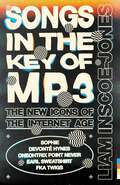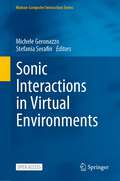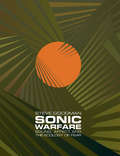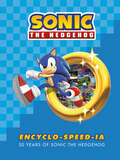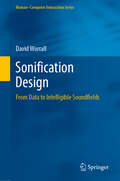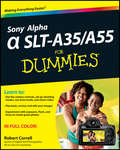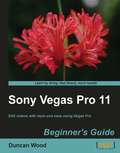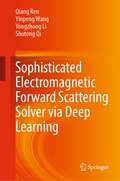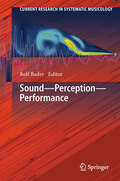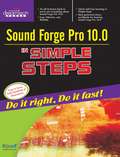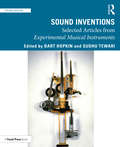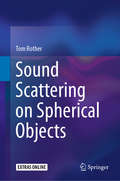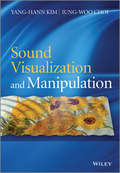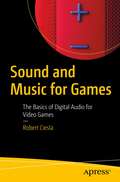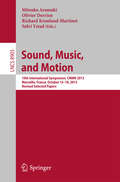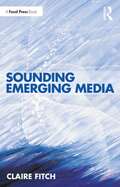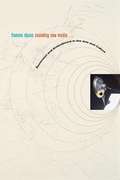- Table View
- List View
Songs In The Key of MP3: The New Icons of the Internet Age
by Liam Inscoe-JonesIt's 2013. You're a teenager squinting at your laptop in the dead of night, flicking between iTunes and YouTube and PirateBay. Endless reams of artists unspool at the click of a button. New forms of musical discovery open up before your very eyes. This evolving digital landscape exists beyond the radio, HMV and even the most extensive record collection. You've entered a whole new world and, suddenly, just about everything feels possible.In Songs in the Key of MP3: The New Icons of the Internet Age, Liam Inscoe-Jones explores five contemporary artists who broke the old rules of sound, style and the music industry at large: Devonté Hynes (of Blood Orange), FKA Twigs, Oneohtrix Point Never, Earl Sweatshirt and SOPHIE. Each began their careers as obscure outsiders but, over time, they helped to re-shape pop culture in their image. Through these five extraordinary figures and an eclectic supporting cast of dozens more, Inscoe-Jones paints a picture of the sonic landscape of the last ten years, exploring the influence of their dazzling music on pop culture, the internet and ourselves.An unorthodox mix of criticism, biography and music history - and featuring interviews with the likes of Caroline Polachek, Daniel Lopatin and Nicolás Jaar - Songs in the Key of MP3 is a book of endless curiosity and wonder; a salutary attempt to define pop culture in a fast and ephemeral age.
Songs In The Key of MP3: The New Icons of the Internet Age
by Liam Inscoe-JonesIt's 2013. You're a teenager squinting at your laptop in the dead of night, flicking between iTunes and YouTube and PirateBay. Endless reams of artists unspool at the click of a button. New forms of musical discovery open up before your very eyes. This evolving digital landscape exists beyond the radio, HMV and even the most extensive record collection. You've entered a whole new world and, suddenly, just about everything feels possible.In Songs in the Key of MP3: The New Icons of the Internet Age, Liam Inscoe-Jones explores five contemporary artists who broke the old rules of sound, style and the music industry at large: Devonté Hynes (of Blood Orange), FKA Twigs, Oneohtrix Point Never, Earl Sweatshirt and SOPHIE. Each began their careers as obscure outsiders but, over time, they helped to re-shape pop culture in their image. Through these five extraordinary figures and an eclectic supporting cast of dozens more, Inscoe-Jones paints a picture of the sonic landscape of the last ten years, exploring the influence of their dazzling music on pop culture, the internet and ourselves.An unorthodox mix of criticism, biography and music history - and featuring interviews with the likes of Caroline Polachek, Daniel Lopatin and Nicolás Jaar - Songs in the Key of MP3 is a book of endless curiosity and wonder; a salutary attempt to define pop culture in a fast and ephemeral age.
Sonic Engagement: The Ethics and Aesthetics of Community Engaged Audio Practice (Routledge Advances in Theatre & Performance Studies)
by Sarah Woodland Wolfgang VachonSonic Engagement examines the relationship between community engaged participatory arts and the cultural turn towards audio, sound, and listening that has been referred to as the 'sonic turn'. This edited collection investigates the use of sound and audio production in community engaged participatory arts practice and research. The popularity of podcast and audio drama, combined with the accessibility and portability of affordable field recording and home studio equipment, makes audio a compelling mode of participatory creative practice. This book maps existing projects occurring globally through a series of case study chapters that exemplify community engaged creative audio practice. The studies focus on audio and sound-based arts practices that are undertaken by artists and arts-led researchers in collaboration with (and from within) communities and groups. These practices include—applied audio drama, community engaged podcasting, sound and verbatim theatre, participatory sound art, community-led acoustic ecology, sound and media walks, digital storytelling, oral history and reminiscence, and radio drama in health and community development. The contributors interrogate the practical, political, and aesthetic potentialities of using sound and audio in community engaged arts practice, as well as its tensions and possibilities as an arts-led participatory research methodology. This book provides the first extensive analysis of what sound and audio brings to participatory, interdisciplinary, arts-led approaches, representing a vital resource for community arts, performance practice, and research in the digital age.
Sonic Interactions in Virtual Environments (Human–Computer Interaction Series)
by Stefania Serafin Michele GeronazzoThis open access book tackles the design of 3D spatial interactions in an audio-centered and audio-first perspective, providing the fundamental notions related to the creation and evaluation of immersive sonic experiences. The key elements that enhance the sensation of place in a virtual environment (VE) are:Immersive audio: the computational aspects of the acoustical-space properties of Virutal Reality (VR) technologies Sonic interaction: the human-computer interplay through auditory feedback in VEVR systems: naturally support multimodal integration, impacting different application domainsSonic Interactions in Virtual Environments will feature state-of-the-art research on real-time auralization, sonic interaction design in VR, quality of the experience in multimodal scenarios, and applications. Contributors and editors include interdisciplinary experts from the fields of computer science, engineering, acoustics, psychology, design, humanities, and beyond. Their mission is to shape an emerging new field of study at the intersection of sonic interaction design and immersive media, embracing an archipelago of existing research spread in different audio communities and to increase among the VR communities, researchers, and practitioners, the awareness of the importance of sonic elements when designing immersive environments.
Sonic Warfare: Sound, Affect, and the Ecology of Fear (Technologies of Lived Abstraction)
by Steve GoodmanAn exploration of the production, transmission, and mutation of affective tonality—when sound helps produce a bad vibe. Sound can be deployed to produce discomfort, express a threat, or create an ambience of fear or dread—to produce a bad vibe. Sonic weapons of this sort include the “psychoacoustic correction” aimed at Panama strongman Manuel Noriega by the U.S. Army and at the Branch Davidians in Waco by the FBI, sonic booms (or “sound bombs”) over the Gaza Strip, and high-frequency rat repellants used against teenagers in malls. At the same time, artists and musicians generate intense frequencies in the search for new aesthetic experiences and new ways of mobilizing bodies in rhythm. In Sonic Warfare, Steve Goodman explores these uses of acoustic force and how they affect populations. Traversing philosophy, science, fiction, aesthetics, and popular culture, he maps a (dis)continuum of vibrational force, encompassing police and military research into acoustic means of crowd control, the corporate deployment of sonic branding, and the intense sonic encounters of sound art and music culture.Goodman concludes with speculations on the not yet heard—the concept of unsound, which relates to both the peripheries of auditory perception and the unactualized nexus of rhythms and frequencies within audible bandwidths.
Sonic the Hedgehog Encyclo-speed-ia
by Ian Flynn SEGACelebrate Sonic the Hedgehog's 30th anniversary with a full-color hardcover historical retrospective that explores nearly every one of the blue speedster's video game appearances!Dive deep into the extensive lore and exhaustive detail of each game in Sonic's ever-expanding universe--from the beloved SEGA Genesis to the most bleeding-edge video game consoles. This tome leaves no stone unturned, showcasing in-depth looks at the characters, settings, and stories from each exciting installment!Dark Horse Books and SEGA present the Sonic the Hedgehog Encyclo-Speed-ia--a must-have volume for any fan of Sonic, young or old!
Sonification Design: From Data to Intelligible Soundfields (Human–Computer Interaction Series)
by David WorrallThe contemporary design practice known as data sonification allows us to experience information in data by listening. In doing so, we understand the source of the data in ways that support, and in some cases surpass, our ability to do so visually. In order to assist us in negotiating our environments, our senses have evolved differently. Our hearing affords us unparalleled temporal and locational precision. Biological survival has determined that the ears lead the eyes. For all moving creatures, in situations where sight is obscured, spatial auditory clarity plays a vital survival role in determining both from where the predator is approaching or to where the prey has escaped. So, when designing methods that enable listeners to extract information from data, both with and without visual support, different approaches are necessary. A scholarly yet approachable work by one of the recognized leaders in the field of auditory design, this book will - Lead you through some salient historical examples of how non-speech sounds have been used to inform and control people since ancient times. - Comprehensively summarize the contemporary practice of Data Sonification. - Provide a detailed overview of what information is and how our auditory perceptions can be used to enhance our knowledge of the source of data. - Show the importance of the dynamic relationships between hearing, cognitive load, comprehension, embodied knowledge and perceptual truth. - Discuss the role of aesthetics in the dynamic interplay between listenability and clarity. - Provide a mature software framework that supports the practice of data sonification design, together with a detailed discussion of some of the design principles used in various examples. David Worrall is an internationally recognized composer, sound artist and interdisciplinary researcher in the field of auditory design. He is Professor of Audio Arts and Acoustics at Columbia College Chicago and a former elected president of the International Community for Auditory Display (ICAD), the leading organization in the field since its inception over 25 years ago.Code and audio examples for this book are available athttps://github.com/david-worrall/springer/ Here is an excellent review of the book by Dr Gregory Kramer: “Worrall proceeds bravely through the trees and vines of philosophy, information theory, aesthetics, and other contributors to sonification design theory. It’s a feat. He nails all of this down with the specific implementation system he’s designed over many years, and applies his theories to specific problems. In a field of research still in its first half century and setting its bearings in a world where human perception has become a sideshow to machine learning, deep learning, and artificial intelligence, the roots David provides will serve well.” Dr Gregory Kramer is the founding figure in the emerging field of sonification, founded the International Conference on Auditory Display (ICAD) and editor of the first book in the field, "Auditory Display: Sonification, Audification and Auditory Interfaces" (Addison Wesley, 1994).
Sony A200 (Focal Digital Camera Guides)
by Shawn BarnettFocal Digital Camera Guides: Sony A200 Just bought a Sony A200 and looking to combine practical know-how with inspiration? This one-stop, easy-to-read guide covers all the basic functions of the camera, and everything beyond.For the basics, turn to the quick start guide, which will get you up and running in five minutes.For an understanding of your camera's many controls and features, check out the section called "The Camera." If all you need is a quick explanation, you'll find it. If you're looking for the whole story, you'll find that, too. Settings that affect how your pictures look are accompanied by full-color examples that show you exactly what you can expect. This section also covers the camera's menus, playback features, memory, and power sources.The section called "Software" shows you how to get the most out of your camera's software. It covers RAW conversion, storing your images, managing your library, and backup strategies.Ultimately, this book's greatest strength isn't its focus on the camera or the software; it's the detailed, easy-to-follow instruction it offers on using your camera to take truly superior photographs. Sections devoted to lenses, subject matter, and light cover these variables in depth, always presenting the most effective techniques in the context of the Sony A200. Written by an experienced photographer, The Sony A200 Digital Camera Guide shows you how to get the shots you can see in your head but have never been able to capture with a camera.* The quick start guide will have you taking great photos in ten minutes.* In-depth coverage of every feature and control ensures that you have access to the tools you need for every shot.* Full-color examples demonstrate how different settings affect your photos.* Expert coverage of lenses, lighting, and subject matter gives you the practical knowledge you need to go after any shot.* Step-by-step instructions on photo editing and image management help you get the most out of your camera's software.* A detailed review of accessories for your camera explains which of these add-ons offer the most value for your needs.* Several tips and tricks prepare you for every situation you're likely to encounter - in the field, at the studio, or at your next wedding or family reunion.
Sony A300/A350: Focal Digital Camera guides
by Shawn BarnettFocal Digital Camera Guides: Sony A300/A350 Just bought a Sony A300 or A350 and looking to combine practical know-how with inspiration? This one-stop, easy-to-read guide covers all the basic functions of the camera, and everything beyond. For the basics, turn to the quick start guide, which will get you up and running in five minutes. For an understanding of your camera's many controls and features, check out the section called "The Camera." If all you need is a quick explanation, you'll find it. If you're looking for the Whole Story, you'll find that, too. Settings that affect how your pictures look are accompanied by full-color examples that show you exactly what you can expect. This section also covers the camera's menus, playback features, memory, and power sources. The section called "Software" shows you how to get the most out of your camera's software. It covers tethered shooting, color management, RAW conversion, storing your images, managing your library, and backup strategies - to name just a few topics. Ultimately, this book's greatest strength isn't its focus on the camera or the software; it's the detailed, easy-to-follow instruction it offers on using your camera to take truly superior photographs. Sections devoted to lenses, subject matter, and light cover these variables in depth, always presenting the most effective techniques in the context of the Sony A300/A350. Written by a widely acclaimed photographer, Sony A300/A350 shows you how to get the shots you can see in your head but have never been able to capture with a camera. * The quick start guide will have you taking great photos in five minutes. * In-depth coverage of every feature and control ensures that you have access to the tools you need for every shot. * Full-color examples demonstrate how different settings affect your photos. * Expert coverage of lenses, lighting, and subject matter gives you the practical knowledge you need to go after any shot. * Step-by-step instructions on photo editing and image management help you get the most out of your camera's software. * A detailed review of accessories for your camera explains which of these add-ons offer the most value for your needs. * Dozens of tips and tricks prepare you for every situation you're likely to encounter - in the field, at the studio, or at your next wedding or family reunion.
Sony Alpha SLT-A35 / A55 For Dummies
by Robert CorrellA practical, step-by-step guide to Sony's most popular new dSLRsSony's new a35 and a55 camera models offer a full range of dSLR features, including pre-sets and auto modes for beginners as well as full manual control over exposure and a unique translucent mirror option. This friendly For Dummies guide gets new dSLR users up to speed and helps more experienced photographers take full advantage of the many options these cameras offer. It covers all the basic camera controls and explains how to set up shooting modes, shoot video, master exposure and focus, edit images, and more.Sony's a35 and a55 models offer a full range of dSLR features and a translucent mirror option, this guide helps new and experienced photographers take full advantage of them allCovers setting up the camera, using all the basic and advanced controls, using auto mode, and shooting video Explores controls that handle exposure, flash, focus, and color, and how to make these elements work to create a great photoExplains image playback, review, and basic editingSony a35/a55 For Dummies gets you up and running with your new Sony dSLR quickly and helps you make the most of everything it has to offer.
Sony Alpha SLT-A65/A77 For Dummies
by Robert CorrellJust what you need to get up and running with Sony's new flagship dSLRs The Sony a77, with its 24. 3 megapixel sensor, full HD video capability, and translucent mirror system, is poised to be Sony's flagship dSLR camera. With many of the same features but at a lower price point, the a65 is the economy version. This guide will cover all the important steps for getting the most from either model. It shows how to set up the camera to get great shots immediately, explains all the controls and shooting modes, shows how to review images and make basic edits, and offers valuable advice on taking super photos using manual settings. Sony's new a65 and a77 dSLRs feature a huge megapixel sensor, HD video, generous ISO range, and the translucent mirror system unique to Sony This easy-to-follow guide helps you make the most of your investment with complete coverage of all the basic and advanced settings and shooting modes Covers shooting in auto mode, shooting HD video, and taking manual control over exposure, focus, and lighting Explains how to play back images and perform basic edits as well as how to manipulate flash, focus, and color to create top-quality photos With Sony a65/a77 For Dummies, bestselling photography author Robert Correll gives new Sony dSLR users confidence and helps them get everything they paid for in these exciting new Sony camera models.
Sony Vegas Pro 11 Beginner’s Guide
by Duncan WoodThe book takes a clear, step-by-step approach to guide you through the process creating a video project with Vegas Pro. With each chapter, you will "level up" your video editing skills,Are you keen on creating professional quality videos? You know little or nothing about video editing and Vegas Pro? Then this book is a perfect fit for you to dive headfirst into video production with Vegas Pro.
Sophie Loves Jimmy
by Nancy RuePaired with her classmate Jimmy for school and church projects, twelve-year-old Sophie must find a way to dispel the boyfriend rumors and to stop the cyberbullying campaign directed against her and a former school bad boy.
Sophisticated Electromagnetic Forward Scattering Solver via Deep Learning
by Qiang Ren Yinpeng Wang Yongzhong Li Shutong QiThis book investigates in detail the deep learning (DL) techniques in electromagnetic (EM) near-field scattering problems, assessing its potential to replace traditional numerical solvers in real-time forecast scenarios. Studies on EM scattering problems have attracted researchers in various fields, such as antenna design, geophysical exploration and remote sensing. Pursuing a holistic perspective, the book introduces the whole workflow in utilizing the DL framework to solve the scattering problems. To achieve precise approximation, medium-scale data sets are sufficient in training the proposed model. As a result, the fully trained framework can realize three orders of magnitude faster than the conventional FDFD solver. It is worth noting that the 2D and 3D scatterers in the scheme can be either lossless medium or metal, allowing the model to be more applicable. This book is intended for graduate students who are interested in deep learning with computational electromagnetics, professional practitioners working on EM scattering, or other corresponding researchers.
Sound - Perception - Performance
by Rolf BaderMusical Performance covers many aspects like Musical Acoustics, Music Psychology, or motor and prosodic actions. It deals with basic concepts of the origin or music and its evolution, ranges over neurocognitive foundations, and covers computational, technological, or simulation solutions. This volume gives an overview about current research in the foundation of musical performance studies on all these levels. Recent concepts of synchronized systems, evolutionary concepts, basic understanding of performance as Gestalt patterns, theories of chill as performance goals or historical aspects are covered. The neurocognitive basis of motor action in terms of music, musical syntax, as well as therapeutic aspects are discussed. State-of-the-art applications in performance realizations, like virtual room acoustics, virtual musicians, new concepts of real-time physical modeling using complex performance data as input or sensor and gesture studies with soft- and hardware solutions are presented. So although the field is still much larger, this volume presents current trends in terms of understanding, implementing, and perceiving performance.
Sound Design for the Visual Storyteller: Creating Sound for Visual Media
by Christopher D. AndersonSound Design for the Visual Storyteller is an overview of the sound design process for the beginner filmmaker or storyteller, providing the foundational knowledge needed to succeed at utilizing and designing sound for visual stories, films, and even podcasts.With a focus on television and film, alongside references to podcast, theatre, event, and game sound design, this all-in-one overview begins with the fundamentals of sound and the structure of a professional sound design team, before exploring the practical topics of post-production, creative workflows, and distribution. Supported by a plethora of audio and video examples to demonstrate key concepts, this book guides aspiring sound designers on the power and production value of the well-conceived soundtrack and showcases some of the most effective techniques for getting there.This is an ideal introduction for storytellers working in a range of contexts, including filmmakers, sound designers, and sound editors, as well as students of sound for film and broadcast.
Sound Forge Pro 10.0 In Simple Steps
by Kogent Learning Solutions IncSound Forge Pro 10.0 in Simple Steps helps you learn Sound Forge, a leading application developed by Sony for sound editing. Ample illustrations, easy to understand language, and precise information about the basic concepts of sound editing are few key points that make it stand apart from the rest of the books. The book is ideal for beginners looking for career opportunities in the domain of sound editing as well as professionals who are keen to upgrade their skills in this field.
Sound Inventions: Selected Articles from Experimental Musical Instruments (Sound Design)
by Bart Hopkin Sudhu TewariSound Inventions is a collection of 34 articles taken from Experimental Musical Instruments, the seminal journal published from 1984 through 1999. In addition to the selected articles, the editors have contributed introductory essays, placing the material in cultural and temporal context, providing an overview of the field both before and after the time of original publication. The Experimental Musical Instruments journal contributed extensively to a number of sub-fields, including sound sculpture and sound art, sound design, tuning theory, musical instrument acoustics, timbre and timbral perception, musical instrument construction and materials, pedagogy, and contemporary performance and composition. This book provides a picture of this important early period, presenting a wealth of material that is as valuable and relevant today as it was when first published, making it essential reading for anyone researching, working with or studying sound.
Sound Scattering on Spherical Objects
by Tom RotherThis book introduces readers to scattering from a practical/numerical point of view. The focus is on basic aspects like single scattering, multiple scattering, and whether inhomogeneous boundary conditions or inhomogeneous scatterers have to be taken into account. The powerful T-matrix approach is explained in detail and used throughout the book, and iterative solution methods are discussed. In addition, the book addresses appropriate criteria for estimating the accuracy of numerical results, as well as their importance for practical applications. Python code is provided with each chapter, and can be freely used and modified by readers. Moreover, numerous scattering results for different configurations are provided for benchmarking purposes. The book will be particularly valuable for those readers who plan to develop their own scattering code, and wish to test the correct numerical implementation of the underlying mathematics.
Sound Visualization and Manipulation
by Yang-Hann Kim Jung-Woo ChoiUnique in addressing two different problems – sound visualization and manipulation – in a unified way Advances in signal processing technology are enabling ever more accurate visualization of existing sound fields and precisely defined sound field production. The idea of explaining both the problem of sound visualization and the problem of the manipulation of sound within one book supports this inter-related area of study. With rapid development of array technologies, it is possible to do much in terms of visualization and manipulation, among other technologies involved with the spatial distribution of sound. This book aims to explore various basic functions for the visualization and manipulation and demonstrate to the reader how these properties determine the quality of visualization and manipulation. The first half of the book introduces some basic and general concepts and theories and the second part of the book explains a number of techniques in sound visualization and manipulation. It offers a unified presentation to two very different topics - sound field visualization techniques based on microphone arrays, and techniques for generation of controlled sound fields using loudspeaker arrays. The authors emphasize the similarities between these two physical problems and between the mathematical methods used for solving them. With extensive examples throughout the book, chapters include: Acoustic Wave Equation and its Basic Physical Measures, Acoustic Wave Equation and its Basic Physical Measures, Basic Theory of Sound Visualization, Acoustic Holography, Beamforming, Basic Theory of Sound Manipulation, Sound Focusing, and Sound Field Reproduction. The first book to combine both the visualization and manipulation of sound technologies in one comprehensive volume Presents the basic concepts using simple one dimensional cases and then extends the concept to three dimensional cases, enabling easier understanding of the fundamental concepts through the use of minimum mathematics Provides a solid understanding of associated physics as well as mathematical concepts for understanding the technologies, addressing diffraction problems in an integrated format by using Kirchhoff-Helmholtz integral equation Uses extensive examples demonstrating the benefits and drawbacks of various applications, including beamforming and acoustic holography A valuable resource forpost/graduate students, acoustic engineers, audio and noise control system developers
Sound and Image: Aesthetics and Practices (Sound Design)
by Andrew Knight-HillSound and Image: Aesthetics and Practices brings together international artist scholars to explore diverse sound and image practices, applying critical perspectives to interrogate and evaluate both the aesthetics and practices that underpin the audiovisual. Contributions draw upon established discourses in electroacoustic music, media art history, film studies, critical theory and dance; framing and critiquing these arguments within the context of diverse audiovisual practices. The volume’s interdisciplinary perspective contributes to the rich and evolving dialogue surrounding the audiovisual, demonstrating the value and significance of practice-informed theory, and theory derived from practice. The ideas and approaches explored within this book will find application in a wide range of contexts across the whole scope of audiovisuality, from visual music and experimental film, to narrative film and documentary, to live performance, sound design and into sonic art and electroacoustic music. This book is ideal for artists, composers and researchers investigating theoretical positions and compositional practices which bring together sound and image.
Sound and Music for Games: The Basics of Digital Audio for Video Games
by Robert CieslaGrasp the fundamentals of digital audio work in the context of video games, including the basics of middleware such as Fmod and Wwise. We will review software such as Apple's Logic and Garageband, Paul Davis's Ardour, and many other popular digital audio workstations. We will start with an introduction to the basic terminology of digital audio work while also getting acquainted with current generation audio hardware. We will then discuss the basics of the venerable Musical Instrument Digital Interface (MIDI) and how it relates to music composition as well as the tools and techniques for writing tracker music/chiptunes. The book also covers plug-in software, soundproofing at home, and voice work. The book takes a practical approach while tackling both hardware and software components used in cutting edge audio engineering, composition, and audio monitoring. What You Will Learn • Understand the fundamentals of digital audio production in the context of video games • Learn about audio integration with popular middleware solutions and APIs • Leverage plugin effects software to sculpt your audio to professional levels • Identify modern audio file formats and how and when to use them • Learn best practices when mixing sound effects and music for video games Who Is This Book For The intended readership includes beginners in digital audio engineering who use Windows, macOS, or Linux.
Sound, Music, and Motion
by Mitsuko Aramaki Olivier Derrien Richard Kronland-Martinet Sølvi YstadThis book constitutes the thoroughly refereed post-conference proceedings of the 10th International Symposium on Computer Music Modeling and Retrieval, CMMR 2013, held in Marseille, France, in October 2013. The 38 conference papers presented were carefully reviewed and selected from 94 submissions. The chapters reflect the interdisciplinary nature of this conference with following topics: augmented musical instruments and gesture recognition, music and emotions: representation, recognition, and audience/performers studies, the art of sonification, when auditory cues shape human sensorimotor performance, music and sound data mining, interactive sound synthesis, non-stationarity, dynamics and mathematical modeling, image-sound interaction, auditory perception and cognitive inspiration, and modeling of sound and music computational musicology.
Sounding Emerging Media
by Claire FitchSounding Emerging Media details a practice-based approach to sonic art and electroacoustic composition, drawing on methodologies inspired by the production of electronic literature, and game development. Using the structural concepts identified by Gilles Deleuze and Félix Guattari, the book is based around ideas related to labels such as Assemblage, Strata, Smooth and Striated Space, Temporal Space and, The Fold. The processes employed to undertake this research involved the creation of original texts, the development of frameworks for improvisation, the use of recordings within the process and implementation of techniques drawn from the practices of electroacoustic composition, and the use of ideas borrowed from electronic literature, publishing and game development. The results have helped to shape a compositional style which draws on these processes individually or collectively, drawing on practice often seen in game development, visual scores and composition using techniques found in electroacoustic music. Providing a journey through the landscape of emerging digital media, Sounding Emerging Media envisages a world where the composer/user/listener all become part of a continuum of collective artistry. This book is the ideal guide to the history and creation of audio for innovative digital media formats and represents crucial reading for both students and practitioners, from aspiring composers to experienced professionals.
Sounding New Media: Immersion and Embodiment in the Arts and Culture
by Frances DysonThe concept of embodiment, as either a site of resistance to technological incorporation, or a site of excess toward which technology will always aim but never arrive, is no longer adequate to represent the realities of technoculture.
